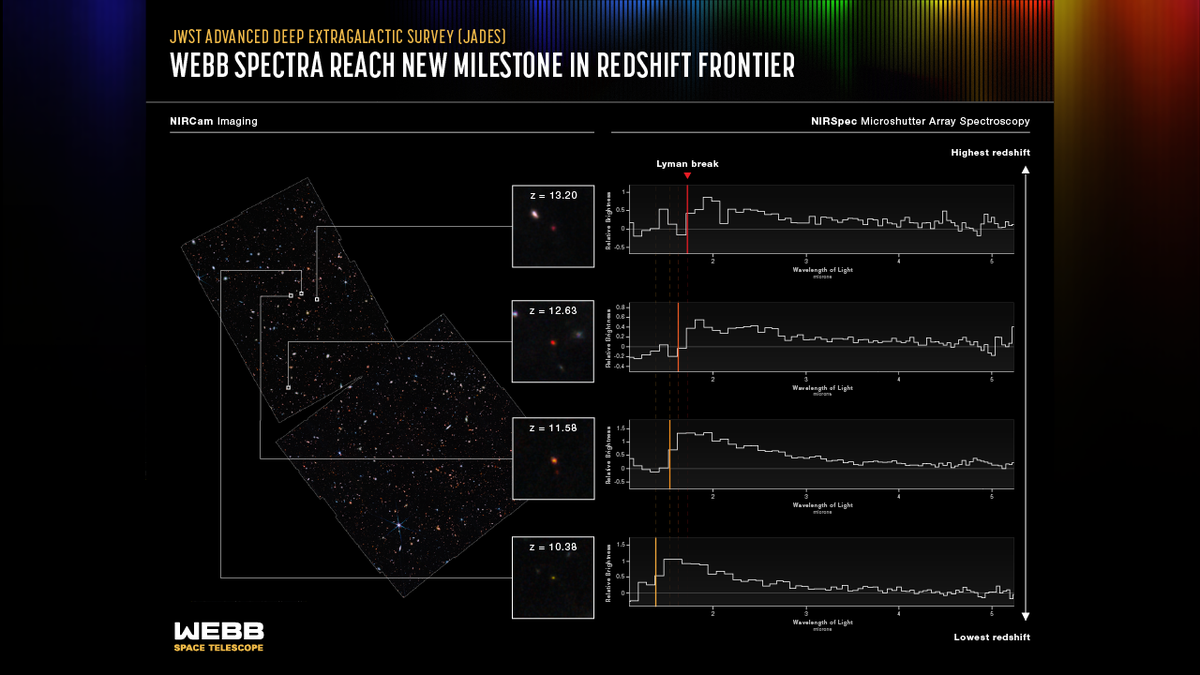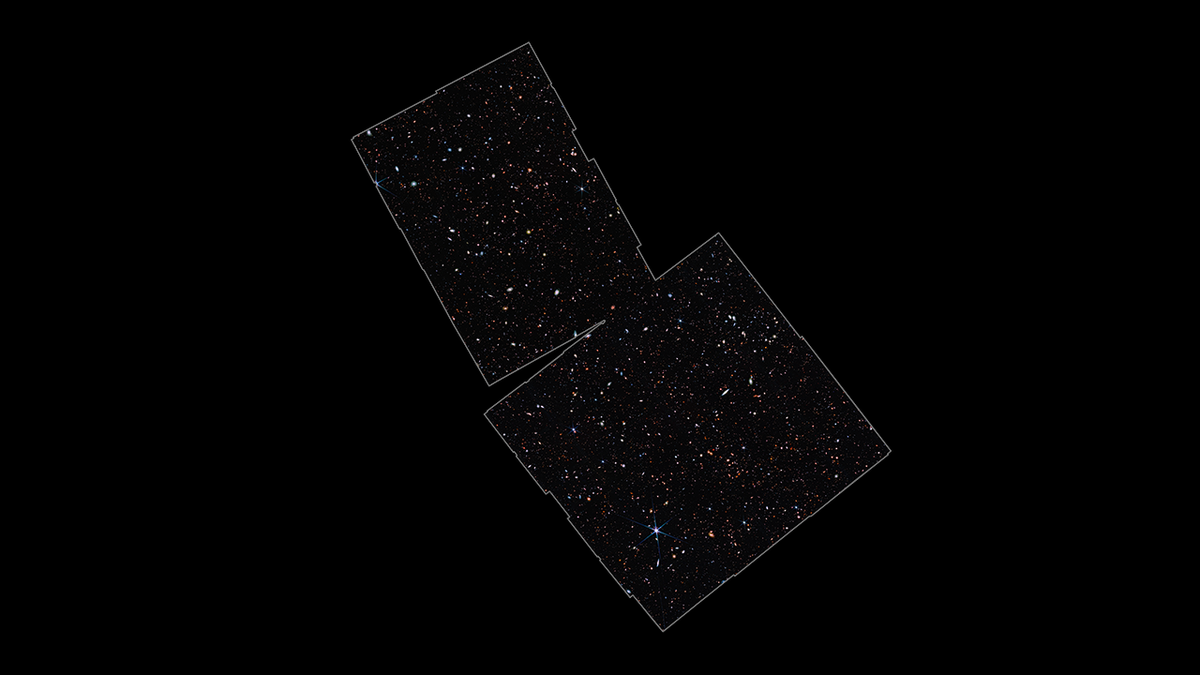Webb Space Telescope allows us to 'look into the past': Theoretical physicist
Theoretical physicist Dr. Michio Kaku explains the significance of new images provided by NASA's Webb Space Telescope on 'Sunday Night in America.'
A group of international astronomers has used data from the James Webb Space Telescope to report the discovery of the earliest galaxies confirmed to date.
In work, which NASA noted has not yet been peer-reviewed, the scientists found that the light from these galaxies has taken more than 13.4 billion years to reach Earth because the galaxies date back to fewer than 400 million years after the Big Bang.
Previous data from Webb had provided candidates for infant galaxies and the targets have been confirmed by obtaining spectroscopic observations.
Those observations revealed characteristic and distinctive patterns in the light emitted from the faint galaxies.
NASA'S ORION SPACECRAFT CAPTURES STUNNING VIDEO OF MOON, EARTH

The Webb Advanced Deep Extragalactic Survey (JADES) focused on the area in and around the Hubble Space Telescope’s Ultra Deep Field. Using Webb’s NIRCam instrument, scientists observed the field in nine different infrared wavelength ranges. From these images (shown at left), the team searched for faint galaxies that are visible in the infrared but whose spectra abruptly cut off at a critical wavelength known as the "Lyman break." Webb’s NIRSpec instrument then yielded a precise measurement of each galaxy’s redshift (shown at right). Four of the galaxies studied are particularly special, as they were revealed to be at an unprecedentedly early epoch. These galaxies date back to less than 400 million years after the Big Bang, when the universe was only 2% of its current age. In the background image, blue represents light at 1.15 microns (115W), green is 2.0 microns (200W) and red is 4.44 microns (444W). In the cutout images, blue is a combination of 0.9 and 1.15 microns (090W+115W), green is 1.5 and 2.0 microns (150W+200W), and red is 2.0, 2.77 and 4.44 microns (200W+277W+444W). (Image Credit: NASA, ESA, CSA, and STScI, M. Zamani (ESA/Webb), L. Hustak (STScI). Science: B. Robertson (UCSC), S. Tacchella (Cambridge), E. Curtis-Lake (Hertfordshire), S. Carniani (Scuola Normale Superiore), and the JADES Collaboration)
Using observations from the JWST Advanced Deep Extragalactic Survey (JADES) program, the observations focused on the area in and around the Hubble Space Telescope’s Ultra Deep Field.
Beginning with the telescope's Near Infrared Camera, or NIRCam, the JADES program used more than 10 days of mission time to observe the field in nine different infrared colors.
In images, the youngest galaxies can be distinguished by the light stretched in wavelength by a factor of up to 14.

GREENBELT, MD - NOVEMBER 02: Engineers and technicians assemble the James Webb Space Telescope November 2, 2016, at NASA's Goddard Space Flight Center in Greenbelt, Maryland. ((Photo by Alex Wong/Getty Images))
NASA said the astronomers searched for faint galaxies that are visible in the infrared but whose light abruptly cuts off at a critical wavelength.
CHINA'S CAPABILITIES POSE POTENTIAL THREAT TO AMERICAN SPACE ASSETS, US MILITARY GENERAL SAYS
The agency noted that the location of the cutoff within each galaxy’s spectrum is shifted by the universe’s expansion.
Then, using the Near-Infrared Spectrograph instrument for three days, the team collected the light from 250 faint galaxies, with study of the patterns on the spectrum by the atoms in each galaxy resulting in a precise measurement of each galaxy’s redshift and revealing the properties of the gas and stars in those galaxies.

This image taken by the James Webb Space Telescope highlights the region of study by the Webb Advanced Deep Extragalactic Survey (JADES). This area is in and around the Hubble Space Telescope’s Ultra Deep Field. Scientists used Webb’s NIRCam instrument to observe the field in nine different infrared wavelength ranges. From these images, the team searched for faint galaxies that are visible in the infrared but whose spectra abruptly cut off at a critical wavelength. They conducted additional observations (not shown here) with Webb’s NIRSpec instrument to measure each galaxy’s redshift and reveal the properties of the gas and stars in these galaxies. In this image, blue represents light at 1.15 microns (115W), green is 2.0 microns (200W) and red is 4.44 microns (444W). (Image Credit: NASA, ESA, CSA, and M. Zamani (ESA/Webb). Science: B. Robertson (UCSC), S. Tacchella (Cambridge), E. Curtis-Lake (Hertfordshire), S. Carniani (Scuola Normale Superiore), and the JADES Collaboration.)
Four of the galaxies were revealed to be unprecedentedly early, lying at redshifts above 10, or when the universe was approximately 330 million years old.
"For the first time, we have discovered galaxies only 350 million years after the Big Bang, and we can be absolutely confident of their fantastic distances," co-author Brant Robertson, from the University of California Santa Cruz and a member of the NIRCam science team, said. "To find these early galaxies in such stunningly beautiful images is a special experience."
CLICK HERE TO GET THE FOX NEWS APP
Next year, JADES will continue with a detailed study of another field, this one centered on the iconic Hubble Deep Field.





















